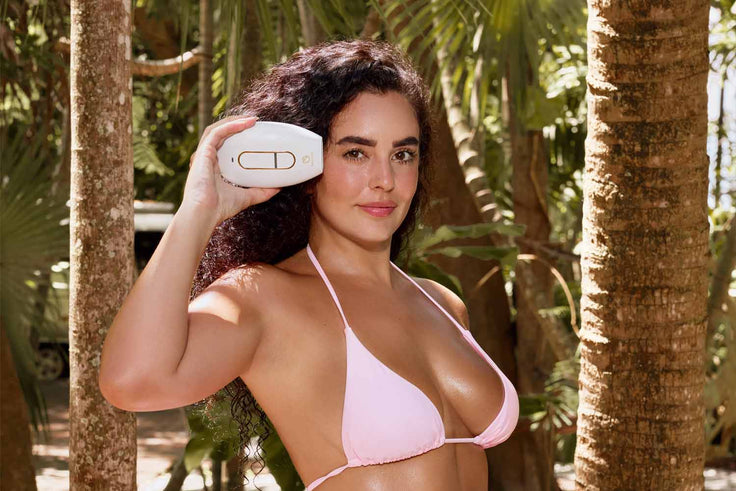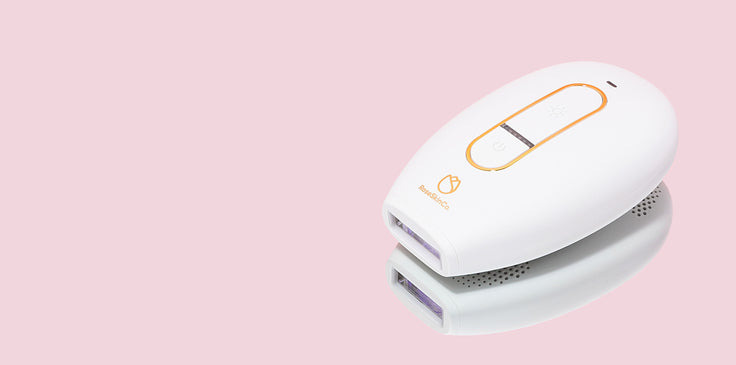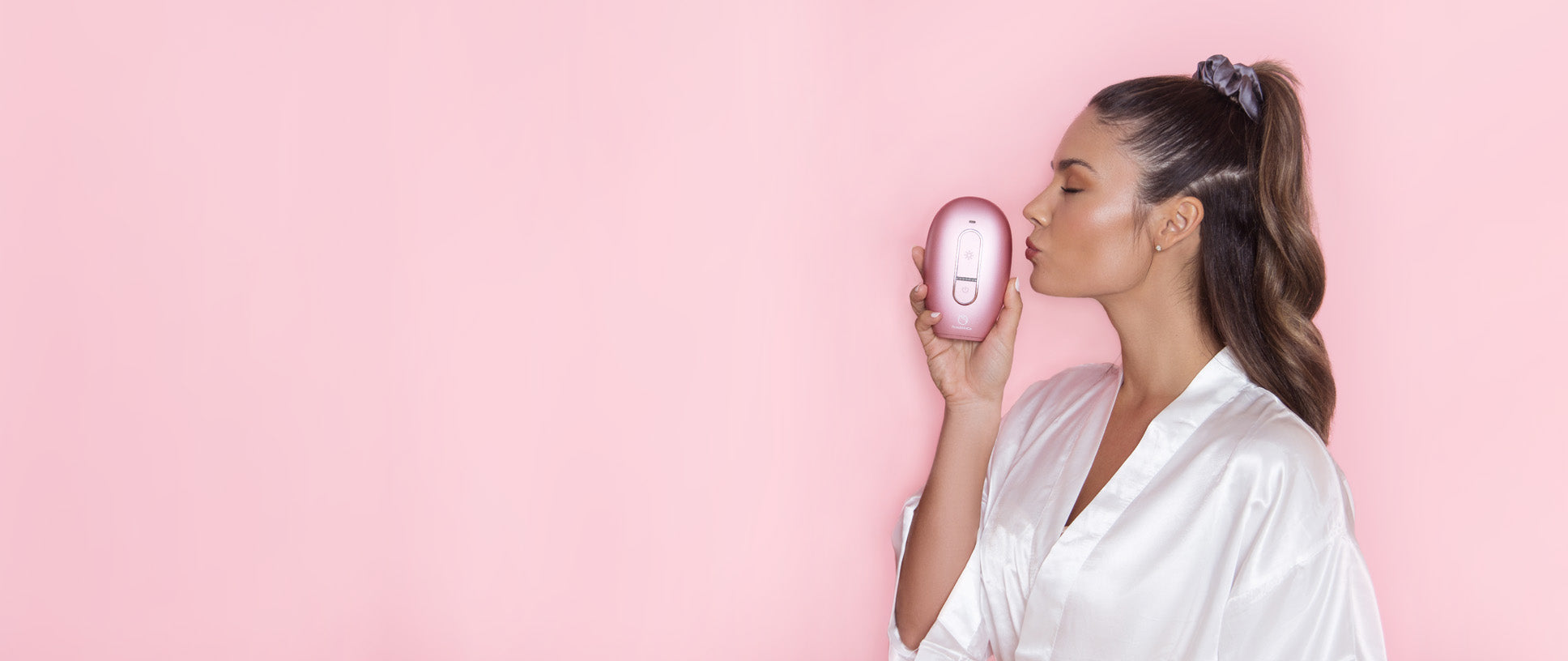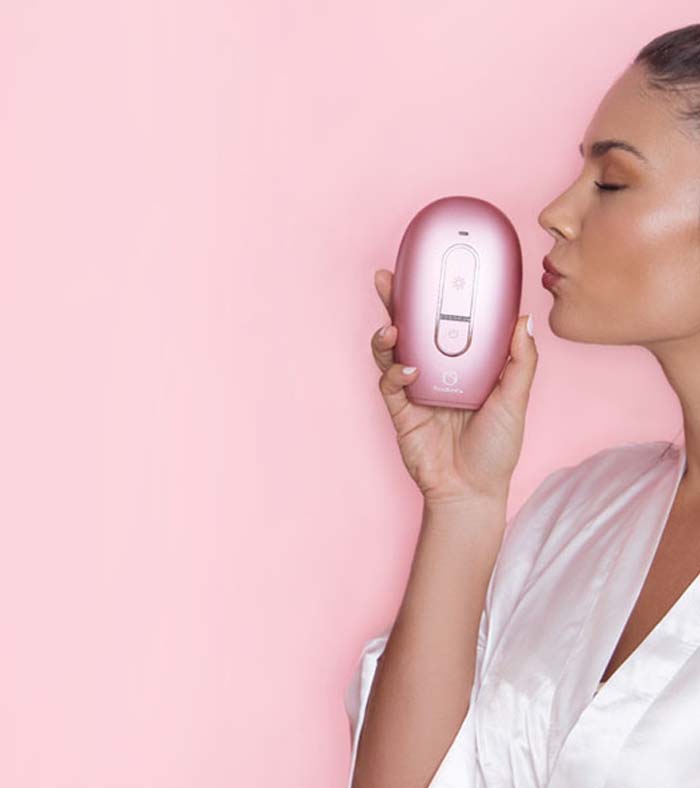So, you have PCOS and you’re dealing with facial hair as a symptom. First of all: sorry, girl. That sucks.
PCOS commonly leads to hirsutism, or excessive hair growth in areas where men typically grow hair. While PCOS facial hair growth is harmless (a lady beard can’t hurt you), it can be a total bummer for anyone who’s going for a soft, smooth, hair-free complexion. Female facial hair is normal, but excessive amounts of it can have a serious impact on self-esteem and confidence.
You didn’t choose to have PCOS – or the thick, unwelcome facial hair that often comes with it. But you CAN choose to get rid of PCOS-related facial hair, if you want to.
Many traditional methods of removing PCOS facial hair are notoriously irritating, time-consuming, and expensive, while only offering short-term results to boot. But with the right hair removal method, you can get rid of that hair permanently, without irritating or damaging your skin.
Basically, you got options. We’ll go over the top ways to get rid of PCOS facial hair, from the best methods from the best-of-the-best to the not-so-great.
TL;DR: Top 10 PCOS Facial Hair Removal Methods (Ranked)
- Intense Pulsed Light (IPL)
- Medication
- Electrolysis
- Laser Hair Removal
- Epilating
- Threading
- Waxing
- Tweezing
- Shaving
- Hair Removal Creams
Top 10 PCOS Facial Hair Removal Methods (Ranked)
Just to be clear: whether or not you get rid of your facial hair is a very personal choice. It’s normal, it’s benign, and you don’t need to let societal beauty standards bully you into doing anything.
But if PCOS-related facial hair is getting in the way of you feeling beautiful… well, we can’t have that. The best way to remove PCOS facial hair is all a matter of preference and suitability, but we’ve ranked every method based on convenience, comfort, cost, and how long results last. Here’s how to remove PCOS facial hair:
1. Intense Pulsed Light (IPL)
This is our #1 favorite way to get rid of PCOS-related facial hair. It’s fast, it’s easy, it’s affordable, it’s pain-free, it’s FDA-cleared, it’s gentle enough for sensitive facial skin, and you can do it on your own. Most importantly, it can help you get rid of female facial hair for good.
IPL devices like Lumi allow you to achieve permanent hair removal at home, with noticeable results in 3 weeks and full results in 6-12 weeks.
IPL technology works by targeting melanin in the hair follicle, then sending light pulses to destroy unwanted body hair at the root. Over time, it leads to a long-term reduction in body hair.
We’ve heard from many women with PCOS that Lumi is their holy grail for facial hair removal. A couple of customer testimonials:
“OMG, I honestly don't believe the change. I've used my handset 3 times so far and I already see a huge difference. I suffer from PCOS (polycystic ovarian syndrome) and one of the symptoms is excess hair. I had to shave my face every single day for years and I was absolutely fed up it (as any woman would be). The facial hair and shaving every day is a jab to my self-esteem and made me feel manly to an extent.
I ordered Lumi a tiny bit skeptical because I had done in-office treatments before and I thought to myself "How is this device going to match up to a professional machine?" Well, you guys proved me wrong and I'm so happy with my purchase so far!
To see the difference I have as quickly as I have speaks volumes. Thank you guys for producing this and I will continue to be a fan and tell everyone about this device!
I know there are other women out there that suffer this reality and I want you to know you're not alone and there is a way to get rid of your facial hair for good! Give this device a try and I promise you will not be disappointed!
I honestly cried while writing this review, that's how happy I am so far! Thank you so much!”
– Nicole
“It actually works! Having lived with PCOS for many years I have tried several of these devices in the past which have never worked. I was thinking of getting laser hair removal again but saw this and decided to give a device another go before parting with a lot of money. I am so pleased that it works and have seen significant reduction along with less time spent removing hair.”
– Hannah C
“LUMI is LUMI-nating my year! I tried Lumi for the first time ever this year and LET ME TELL YOU - It was life-changing. As a PCOS girly who's been struggling with facial hair and also being a hairy girl naturally (LOL), this made my coarse hair more sparse and it doesn't grow overnight anymore!! This is a blessing and I am so GLAD this kind of technology exists! WAYYY more affordable than going to laser hair removal clinics AND no need to feel uncomfortable showing all my hair to people. I love using Lumi at the comfort of my own home! Definitely recommend!!”
– MJ A.
Due to the technology, IPL isn’t a perfect fit for everyone – it requires contrast between hair and skin to work its magic, so it doesn’t work well for very dark skin or very light hair. (Check the IPL Skin Tone Chart.) But if you’re a good candidate for it, IPL is a game-changer for at-home permanent facial hair removal.
2. Medication
Unlike the other entries on this list, this one addresses the problem instead of the symptom.
If you’re dealing with hirsutism caused by PCOS, certain medications may be able to treat your condition by lowering androgen levels. Your doctor might prescribe birth control pills, androgen-suppressing medications, or low-dose steroid medications, among others. It totally depends on your situation.
Medication won’t get rid of ALL of your facial hair, but it may help to tone down the PCOS excess and could address other PCOS symptoms you may be experiencing as well. Ask your doctor if getting on medication might be an option for you.
3. Electrolysis
Electrolysis is another permanent hair removal method. It’s a professional, in-clinic treatment that targets hairs one follicle at a time. During electrolysis, an aesthetician inserts a small needle into the hair follicle, then zaps it with a small current of electricity to destroy it at the root. Then, they remove the hair with tweezers.
Since electrolysis targets individual hairs, it’s an ideal method for small, targeted areas. It typically involves 6 or more treatments spaced a few weeks apart. Electrolysis typically costs a few hundred dollars per treatment – you’ll usually expect to pay $500-1000+ per area.
Electrolysis can be uncomfortable but most say it isn’t especially painful compared to other hair removal methods. It’s also safe and effective for all hair and skin colors.
If you’re not a candidate for IPL hair removal, or if you have the budget and you’d rather go to a professional for permanent PCOS facial hair removal, electrolysis may be a great option.
4. Laser Hair Removal
Laser hair removal is another permanent hair removal method that’s done in-clinic by a professional. It uses a laser device that targets the melanin in dark hair follicles. The technology used is similar to IPL, but laser hair removal targets individual hairs whereas IPL targets a broader area for safe at-home treatment and a quicker process.
Laser hair removal is very effective for PCOS facial hair removal, but it’ll cost ya. Laser hair removal typically costs a few hundred dollars per session and may require up to 12 sessions for full results. But again, if you have the budget for it and don’t mind visiting a clinic multiple times rather than doing your own permanent hair removal routine at home, it can offer fabulous results.
5. Epilating
Epilating doesn’t offer permanent PCOS-related facial hair removal, but for a temporary solution, it’s a good one. An epilator is a mechanical device that pulls hairs out with small tweezers or coils that grab onto hair – think of it as a tweezer x 100. Using a handset, you can do it at home. You know we love that!
You’ll have to let your facial hair regrow between sessions before you’re able to epilate again, and epilating can be pretty painful especially at first. (Pulling hairs out at the root can have that effect.) But results typically last a few weeks at a time, and that’s a lot better than shaving.
6. Threading
Threading is another popular temporary solution to PCOS-related facial hair. It’s an age-old technique that involves pulling hairs out with cotton threads.
You’ll have to go to a professional for this one – it’s really difficult to achieve the right angle on your own, and though it looks simple it’s deceptively tricky – but it’s fast, pretty affordable, and not as painful as some other hair removal methods.
Threading pulls hairs out at the root – it won’t get rid of PCOS-related facial hair for good, but results often last a few weeks.
7. Waxing
Waxing is another popular way to get rid of PCOS-related facial hair. It involves using a sticky substance to rip body hair at the follicle. You can go to a pro or try your hand at DIY – especially if your hair is pretty fine or you’re targeting a small area, DIY waxing face strips are pretty inexpensive and straightforward. But either way, waxing involves an ongoing cost & regular maintenance.
Similar to epilating, you’ll have to let your facial hair grow between waxing sessions. And waxing can be a painful experience – if PCOS has made your skin more sensitive, even the wax itself can be irritating. But since waxing pulls hairs out at the root, results typically last a few weeks at a time.
8. Tweezing
If you’re detail-oriented and have a lot of time on your hands, tweezing might be for you. Tweezing involves grabbing individual hairs with a tweezing tool and yanking them out, one by one. It’s great if you’re targeting a very small area of hair – not so great if your PCOS facial hair really is excessive.
Dermatologists say tweezing may not be the best option for sensitive skin, but it does the trick – especially if you’re primarily concerned about eyebrows or just getting the tweezers out to grab the hairs you missed from another hair removal method. It won’t remove PCOS-related facial hair permanently but it might for a few weeks.
9. Shaving
We mainly put shaving this low because it’s just not at all permanent. Shaving won’t help you get rid of PCOS facial hair for good, it won’t help it grow back thinner over time, and if your hair is especially dark, you might even start to see your hair grow back the very same day.
But facial shaving isn’t all bad. It’s effective, it’s familiar, and it allows for precise, immediate results. If you do choose to shave (either for regular hair removal or to prep your skin for IPL treatment), clean your skin, use a dedicated facial razor instead of your same body razor, and shave in the direction of the hair.
10. Hair Removal Creams
Easy come, easy go. Also known as depilatory creams, hair removal creams are a very simple way to remove PCOS-related facial hair, but results don’t last too long. You slather it on, wait a few minutes, and wash the hair right off. Hair removal creams only remove hair on the skin’s surface, so you’ll likely start to notice hair grow back within a day or so. What’s more, the chemicals in depilatory creams can irritate delicate facial skin – be sure to get one that’s formulated for the face.
Check out other RoseSkinCo products: Sonic Facial Cleansing Brush





